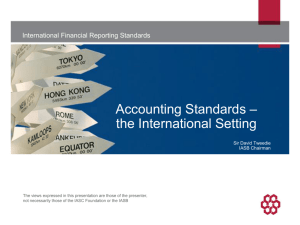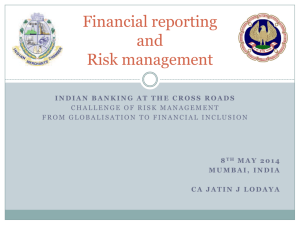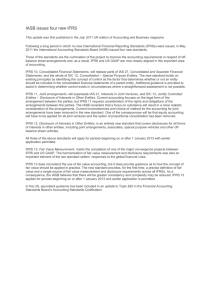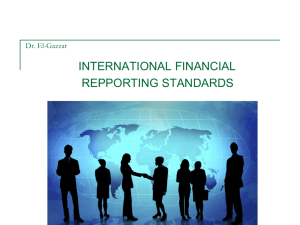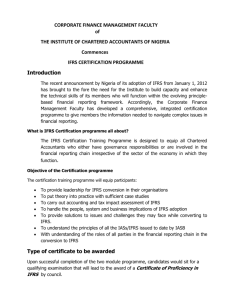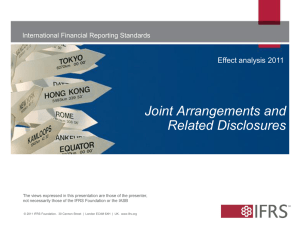Improving the Conceptual Framework
advertisement
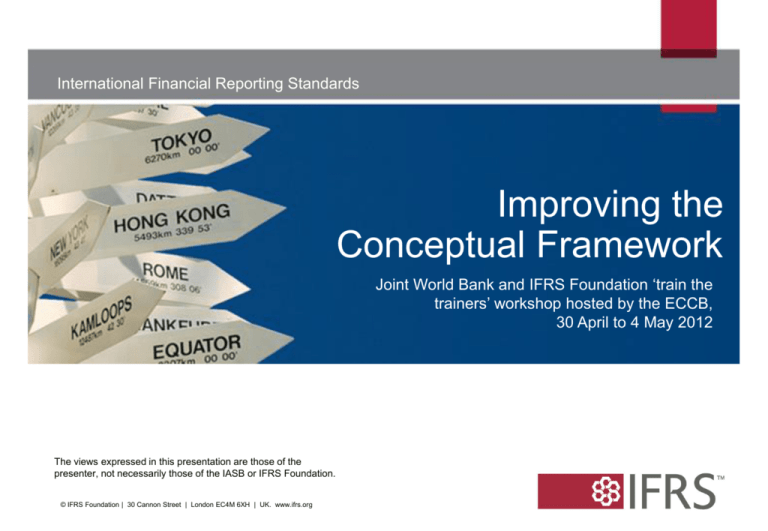
International Financial Reporting Standards Improving the Conceptual Framework Joint World Bank and IFRS Foundation ‘train the trainers’ workshop hosted by the ECCB, 30 April to 4 May 2012 K The Theviews viewsexpressed expressedininthis thispresentation presentationare arethose thoseofofthe the presenter, presenter, not necessarily not necessarily those of the those IASB of or theIFRS IASBFoundation. or IFRS Foundation. © IFRS Foundation | 30 Cannon Street | London EC4M 6XH | UK. www.ifrs.org Role of the Conceptual Framework 2 • Conceptual Framework sets out agreed concepts that underlie financial reporting – objective, qualitative characteristics, element definitions, … • IASB uses Conceptual Framework to set standards – enhances consistency across standards – enhances consistency over time as Board members change – provides benchmark for judgments • Preparers use Conceptual Framework to develop accounting policies in the absence of specific standard or interpretation – IAS 8 hierarchy ©©IFRS | 30 Cannon Street Street | London EC4MEC4M 6XH |6XH UK. |www.ifrs.org 2010Foundation IFRS Foundation. 30 Cannon | London UK. www.ifrs.org Some context… 3 • The concepts are the goal towards which the IASB and preparers of financial reports strive. • As with most goals, the Conceptual Framework’s vision of ideal financial reporting is unlikely to be achieved in full, at least not in the short term, because it takes time to understand, accept and implement new ways of analysing transactions and other events. • Nevertheless, establishing a goal towards which to strive is essential if financial reporting is to evolve so as to improve its usefulness. (CF.OB11) ©©IFRS | 30 Cannon Street Street | London EC4MEC4M 6XH |6XH UK. |www.ifrs.org 2010Foundation IFRS Foundation. 30 Cannon | London UK. www.ifrs.org Improving the Conceptual Framework 4 • Objective (‘old’ project) – To develop an improved and common conceptual framework that will provide a sound foundation for the development of accounting standards • Phases (‘old’ project) 1. Objective of financial reporting and qualitative characteristics of financial reporting information 2. Elements of financial statements and recognition 3. Measurement 4. Reporting entity 5. Presentation and disclosure, including reporting boundaries 6. Purpose and status in GAAP hierarchy 7. Applicability to the not-for-profit sector 8. Entire framework, remaining issues if any ©©IFRS | 30 Cannon Street Street | London EC4MEC4M 6XH |6XH UK. |www.ifrs.org 2010Foundation IFRS Foundation. 30 Cannon | London UK. www.ifrs.org Phase 1 completed in 2010 Objective of financial reporting 5 Objective of financial reporting is to provide financial information about the reporting entity that is useful to existing and potential investors, lenders and other creditors in making decisions about providing resources to the entity Note: • other aspects of the Conceptual Framework flow logically from the objective (CF.OB1) • Conceptual Framework sets out the concepts that underlie IFRS financial statements and assist the IASB in the development of future IFRSs and in its review of existing IFRSs (CF.Purpose and Status) ©©IFRS | 30 Cannon Street Street | London EC4MEC4M 6XH |6XH UK. |www.ifrs.org 2010Foundation IFRS Foundation. 30 Cannon | London UK. www.ifrs.org Phase 1 completed in 2010 Fundamental qualitative characteristics 6 • Relevance: capable of making a difference in users’ decisions – predictive value – confirmatory value – materiality (entity-specific) • Faithful representation: faithfully represents the phenomena it purports to represent – completeness (depiction including numbers and words) – neutrality (unbiased) – free from error (ideally) Note: faithful representation replaces reliability ©©IFRS | 30 Cannon Street Street | London EC4MEC4M 6XH |6XH UK. |www.ifrs.org 2010Foundation IFRS Foundation. 30 Cannon | London UK. www.ifrs.org Phase 1 completed in 2010 Enhancing Qualitative Characteristics 7 • Comparability: like things look alike; different things look different • Verifiability: knowledgeable and independent observers could reach consensus, but not necessarily complete agreement, that a depiction is a faithful representation • Timeliness: having information available to decision-makers in time to be capable of influencing their decisions • Understandability: Classify, characterise, and present information clearly and concisely ©©IFRS | 30 Cannon Street Street | London EC4MEC4M 6XH |6XH UK. |www.ifrs.org 2010Foundation IFRS Foundation. 30 Cannon | London UK. www.ifrs.org Phase 1 completed in 2010 Pervasive constraint 8 • Reporting financial information imposes costs, and it is important that those costs are justified by the benefits of reporting that information. • In applying the cost constraint, the IASB assesses whether the benefits of reporting particular information are likely to justify the costs incurred to provide and use that information. Those assessments are usually based on a combination of quantitative and qualitative information. ©©IFRS | 30 Cannon Street Street | London EC4MEC4M 6XH |6XH UK. |www.ifrs.org 2011Foundation IFRS Foundation. 30 Cannon | London UK. www.ifrs.org Elements 9 Existing element definitions: • Asset: Resource controlled as a result of past events and from which future economic benefits are expected to flow • Liability: Present obligation arising from past events, the settlement of which is expected to result in outflow of resources embodying economic benefits • Equity: Assets minus liabilities • Income (expense): Increases (decreases) in economic benefits during period from inflows or enhancements (outflows or depletions) of assets (liabilities) or decreases (incurrences) of liabilities from in increases (decreases) in equity, other than contributions from (distributions to) equity ©©IFRS | 30 Cannon Street Street | London EC4MEC4M 6XH |6XH UK. |www.ifrs.org 2010Foundation IFRS Foundation. 30 Cannon | London UK. www.ifrs.org Elements • How can we improve the element definitions? • What does expected mean? Is it different from probable? • Why focus on future inflow/outflow of economic benefits, rather than present position? • Why do we need to identify past transactions? • What does control mean in the asset definition? • How does liability definition apply to noncontractual obligations? • Should we define equity? If so, how? ©©IFRS | 30 Cannon Street Street | London EC4MEC4M 6XH |6XH UK. |www.ifrs.org 2010Foundation IFRS Foundation. 30 Cannon | London UK. www.ifrs.org 10 Elements ‘Working’ asset definition 11 • An asset of an entity is a present economic resource to which the entity has a right or other access that others do not have. – Present means that on the financial statement date the economic resource exists and the entity has the right or other access that others do not have. – Economic resource is scarce and capable of producing cash inflows or reducing cash outflows, directly or indirectly, alone or together with other economic resources. Economic resources that arise from contracts and other binding arrangements are unconditional promises and other abilities to require provision of economic resources, including through risk protection. – Right or other access that others do not have enables entity to use the economic resource and its use by others can be precluded or limited. It is enforceable by legal or equivalent means. ©©IFRS | 30 Cannon Street Street | London EC4MEC4M 6XH |6XH UK. |www.ifrs.org 2010Foundation IFRS Foundation. 30 Cannon | London UK. www.ifrs.org Elements ‘Working’ liability definition 12 • A liability of an entity is a present economic obligation for which the entity is the obligor – Present means that on the financial statement date the economic obligation exists and the entity is the obligor. – Economic obligation is an unconditional promise or other requirement to provide or forgo economic resources, including through risk protection. – An entity is the obligor if the entity is required to bear the economic obligation and its requirement to bear the obligation is enforceable by legal or equivalent means. Are these improvements? ©©IFRS | 30 Cannon Street Street | London EC4MEC4M 6XH |6XH UK. |www.ifrs.org 2010Foundation IFRS Foundation. 30 Cannon | London UK. www.ifrs.org Elements 13 • How many elements? Which ones? • Is other comprehensive income an element? If so, how should it be defined? FASB (10) IASB (5) Assets Gains Assets Liabilities Losses Liabilities Equity Revenue Equity Investments by owners Comprehensive Income Income Distributions to owners Expenses Expenses ©©IFRS | 30 Cannon Street Street | London EC4MEC4M 6XH |6XH UK. |www.ifrs.org 2010Foundation IFRS Foundation. 30 Cannon | London UK. www.ifrs.org Recognition/derecognition 14 • Current Framework has two recognition criteria – Probable future economic benefit associated with the item will flow to or from the entity – Item has a cost or value that can be measured reliably • These criteria need clarification – Probable? – Measured reliably? • There are no derecognition criteria • Do we need recognition and derecognition criteria? – Perhaps meeting (or not) the elements definitions and satisfying the qualitative characteristics is sufficient ©©IFRS | 30 Cannon Street Street | London EC4MEC4M 6XH |6XH UK. |www.ifrs.org 2010Foundation IFRS Foundation. 30 Cannon | London UK. www.ifrs.org Elements and recognition/derecognition • This phase of the project has been deferred • Board is not trying to fundamentally change what meets current definitions, just trying to clarify and improve • Has proven to be quite challenging • Perhaps standards-level projects will provide insights – Financial instruments with characteristics of equity – IAS 37 (Provisions) – Insurance – Revenue… ©©IFRS | 30 Cannon Street Street | London EC4MEC4M 6XH |6XH UK. |www.ifrs.org 2010Foundation IFRS Foundation. 30 Cannon | London UK. www.ifrs.org 15 Reporting entity 16 • Nothing in current Conceptual Framework on reporting entity • These are tentative decisions in CF project to date • Circumscribed area of economic activity – Activities are being, have been, or will be conducted – Activities can be objectively distinguished – Provides information for users to make decisions • Legal entity not necessary – Branch or segment of a legal entity could be a reporting entity • Consolidated financial statements are general purpose – May also be a group of entities under common control – Parent-only financial statements useful with consolidated financial statements, but not on their own ©©IFRS | 30 Cannon Street Street | London EC4MEC4M 6XH |6XH UK. |www.ifrs.org 2010Foundation IFRS Foundation. 30 Cannon | London UK. www.ifrs.org Measurement 17 • Framework should set forth concepts for determining appropriate measurement attribute for a particular asset or liability in a given circumstance • However, there is little in current Framework on measurement – List of measurements used in standards – No concepts or basis for choosing among them • Large hole in the literature • Has resulted in ad hoc standards-level decisions in multiplemeasurement environment ©©IFRS | 30 Cannon Street Street | London EC4MEC4M 6XH |6XH UK. |www.ifrs.org 2010Foundation IFRS Foundation. 30 Cannon | London UK. www.ifrs.org Measurement 18 • Current thinking is measurement concepts should be based on objective of financial reporting, qualitative characteristics and elements definitions – Objective of financial reporting is the place to start – Qualitative characteristics and cost constraint would be measurement selection factors – Elements tell us what we are trying to measure • Board does not currently think the Framework should strive to identify a single measurement attribute for all assets and liabilities ©©IFRS | 30 Cannon Street Street | London EC4MEC4M 6XH |6XH UK. |www.ifrs.org 2010Foundation IFRS Foundation. 30 Cannon | London UK. www.ifrs.org Measurement 19 • One approach being considered – Determine view of financial reporting that best meets the objective of financial reporting – Statement of financial position view – Income statement view – Holistic view (statements of financial position and income) – Then identify implications of that view and the fundamental qualitative characteristics for historical costbased and fair value measures • Is it necessary to expand on relevance and faithful representation in measurement chapter? – How and why? ©©IFRS | 30 Cannon Street Street | London EC4MEC4M 6XH |6XH UK. |www.ifrs.org 2010Foundation IFRS Foundation. 30 Cannon | London UK. www.ifrs.org Measurement 20 • Path of this project phase has taken several turns – Range from highly conceptual to writing down what is in existing standards • The measurement phase is controversial – – – – People have firmly held (although often loosely defined) views Measuring things in financial statements is fundamental But there are no concepts to guide the choice of attribute Each of the alternative approaches has significant perceived strengths and weaknesses • Regardless, measurement concepts are sorely needed ©©IFRS | 30 Cannon Street Street | London EC4MEC4M 6XH |6XH UK. |www.ifrs.org 2010Foundation IFRS Foundation. 30 Cannon | London UK. www.ifrs.org Conceptual Framework versus standards-level projects 21 • How can standard setting continue without finishing the Conceptual Framework project first? – we have a Conceptual Framework in place today (not perfect) – Standards-level projects inform Conceptual Framework project and vice-versa (eg liabilities and equity) – Standards need improvement and Conceptual Framework project is likely to take many years; investors cannot wait for better information • Would a completed Conceptual Framework help standard setting? – Yes, particularly measurement – Also, disclosure and presentation ©©IFRS | 30 Cannon Street Street | London EC4MEC4M 6XH |6XH UK. |www.ifrs.org 2010Foundation IFRS Foundation. 30 Cannon | London UK. www.ifrs.org Agenda consultation 22 • Public agenda review every three years • Will help the IASB establish a broad strategic direction for its work plan: – establish a balance between: – improvements (new IFRSs); and – maintenance (implementation) – determine whether to return to projects that have been deferred – identify areas where improvements are needed © IFRS Foundation | 30 Cannon Street | London EC4M 6XH | UK. www.ifrs.org Agenda Consultation The IASB’s initial thinking • Development of financial reporting – – – – Investing in researching key strategic issues Completion of the conceptual framework Completing MoU projects Selected standards-level projects • Maintenance of existing IFRSs – Post-implementation reviews – Responding to implementation needs • Expansion of research function © IFRS Foundation | 30 Cannon Street | London EC4M 6XH | UK. www.ifrs.org 23 Agenda Consultation Feedback to date 24 • 246 comment letters, 4 Roundtables Results will feed into the Board’s agenda setting process • Common views: – Complete the four current projects – Focus on maintenance over development of IFRSs in the near future – Utilise research from national-standard setters and academics – Complete the Conceptual Framework © IFRS Foundation | 30 Cannon Street | London EC4M 6XH | UK. www.ifrs.org Questions or comments? Expressions of individual views by members of the IASB and its staff are encouraged. The views expressed in this presentation are those of the presenter. Official positions of the IASB on accounting matters are determined only after extensive due process and deliberation. ©©IFRS | 30 Cannon Street Street | London EC4MEC4M 6XH |6XH UK. |www.ifrs.org 2010Foundation IFRS Foundation. 30 Cannon | London UK. www.ifrs.org 25 26 The requirements are set out in International Financial Reporting Standards (IFRSs), as issued by the IASB at 1 January 2012 with an effective date after 1 January 2012 but not the IFRSs they will replace. The IFRS Foundation, the authors, the presenters and the publishers do not accept responsibility for loss caused to any person who acts or refrains from acting in reliance on the material in this PowerPoint presentation, whether such loss is caused by negligence or otherwise. © 2011 IFRS Foundation | 30 Cannon | London 6XH | EC4M UK. www.ifrs.org © IFRS Foundation | 30Street Cannon StreetEC4M | London 6XH | UK | www.ifrs.org
